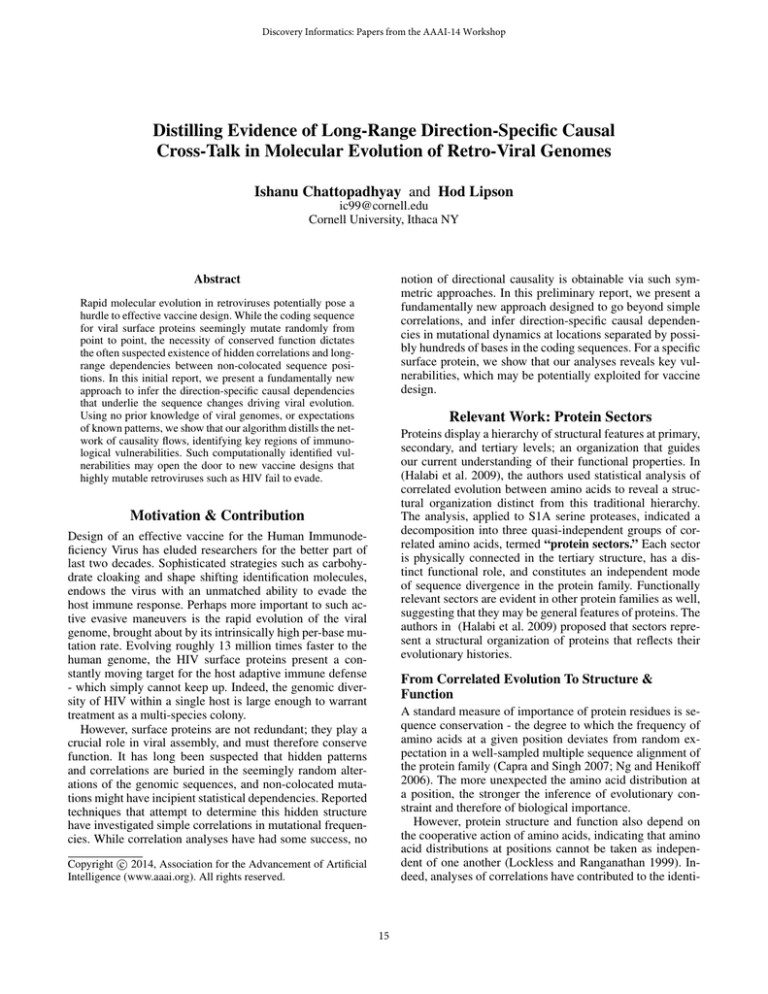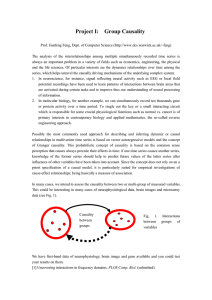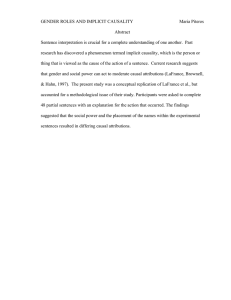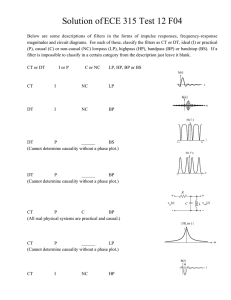
Discovery Informatics: Papers from the AAAI-14 Workshop
Distilling Evidence of Long-Range Direction-Specific Causal
Cross-Talk in Molecular Evolution of Retro-Viral Genomes
Ishanu Chattopadhyay and Hod Lipson
ic99@cornell.edu
Cornell University, Ithaca NY
Abstract
notion of directional causality is obtainable via such symmetric approaches. In this preliminary report, we present a
fundamentally new approach designed to go beyond simple
correlations, and infer direction-specific causal dependencies in mutational dynamics at locations separated by possibly hundreds of bases in the coding sequences. For a specific
surface protein, we show that our analyses reveals key vulnerabilities, which may be potentially exploited for vaccine
design.
Rapid molecular evolution in retroviruses potentially pose a
hurdle to effective vaccine design. While the coding sequence
for viral surface proteins seemingly mutate randomly from
point to point, the necessity of conserved function dictates
the often suspected existence of hidden correlations and longrange dependencies between non-colocated sequence positions. In this initial report, we present a fundamentally new
approach to infer the direction-specific causal dependencies
that underlie the sequence changes driving viral evolution.
Using no prior knowledge of viral genomes, or expectations
of known patterns, we show that our algorithm distills the network of causality flows, identifying key regions of immunological vulnerabilities. Such computationally identified vulnerabilities may open the door to new vaccine designs that
highly mutable retroviruses such as HIV fail to evade.
Relevant Work: Protein Sectors
Proteins display a hierarchy of structural features at primary,
secondary, and tertiary levels; an organization that guides
our current understanding of their functional properties. In
(Halabi et al. 2009), the authors used statistical analysis of
correlated evolution between amino acids to reveal a structural organization distinct from this traditional hierarchy.
The analysis, applied to S1A serine proteases, indicated a
decomposition into three quasi-independent groups of correlated amino acids, termed “protein sectors.” Each sector
is physically connected in the tertiary structure, has a distinct functional role, and constitutes an independent mode
of sequence divergence in the protein family. Functionally
relevant sectors are evident in other protein families as well,
suggesting that they may be general features of proteins. The
authors in (Halabi et al. 2009) proposed that sectors represent a structural organization of proteins that reflects their
evolutionary histories.
Motivation & Contribution
Design of an effective vaccine for the Human Immunodeficiency Virus has eluded researchers for the better part of
last two decades. Sophisticated strategies such as carbohydrate cloaking and shape shifting identification molecules,
endows the virus with an unmatched ability to evade the
host immune response. Perhaps more important to such active evasive maneuvers is the rapid evolution of the viral
genome, brought about by its intrinsically high per-base mutation rate. Evolving roughly 13 million times faster to the
human genome, the HIV surface proteins present a constantly moving target for the host adaptive immune defense
- which simply cannot keep up. Indeed, the genomic diversity of HIV within a single host is large enough to warrant
treatment as a multi-species colony.
However, surface proteins are not redundant; they play a
crucial role in viral assembly, and must therefore conserve
function. It has long been suspected that hidden patterns
and correlations are buried in the seemingly random alterations of the genomic sequences, and non-colocated mutations might have incipient statistical dependencies. Reported
techniques that attempt to determine this hidden structure
have investigated simple correlations in mutational frequencies. While correlation analyses have had some success, no
From Correlated Evolution To Structure &
Function
A standard measure of importance of protein residues is sequence conservation - the degree to which the frequency of
amino acids at a given position deviates from random expectation in a well-sampled multiple sequence alignment of
the protein family (Capra and Singh 2007; Ng and Henikoff
2006). The more unexpected the amino acid distribution at
a position, the stronger the inference of evolutionary constraint and therefore of biological importance.
However, protein structure and function also depend on
the cooperative action of amino acids, indicating that amino
acid distributions at positions cannot be taken as independent of one another (Lockless and Ranganathan 1999). Indeed, analyses of correlations have contributed to the identi-
c 2014, Association for the Advancement of Artificial
Copyright Intelligence (www.aaai.org). All rights reserved.
15
Figure 1: p24 hexamer (3GV2 PDB Database), with neighborhoods of the loci identified above highlighted. Note that the loci
45, 57 correspond to the regions involved in the assembly of the six p24 monomers to form the hexamer. Theses hexamers then
need to assemble to generate the capsid, and this assembly requires molecular interactions around the 201, 217 region.
fication of allosteric mechanisms in proteins (Ferguson et
al. 2007), and even new vaccine design strategies against
HIV (Dahirel et al. 2011).
Far greater insight into protein structure and function
may be obtained if we can infer the causal directions of
positional correlations. Put simply, such inferred directed
causality flow will potentially reveal the fundamental constraints, feedbacks and emergent high-level dynamical relationships on evolutionary change through time. In the context of rapidly evolving viral proteins, analysis of such an
inferred causality network can reveal regions of immunological vulnerabilities, and will provide immediate insights
into vaccine design strategies.
In this initial report, we delineate a theoretically sound
solution to this inference problem. At a conceptual level, we
implement Granger’s notion of causality (Granger 1969):
computing the simple correlation matrix, followed by a cluster analysis would not suffice. Our approach consists of the
following conceptual building blocks:
• Representation of position-specific variational data with
symbol streams: Given a sufficiently large set of sequences
representing variations of a protein of interest, we generate position-specific symbol sequences that capture the
residue variation. As a simple example (See Fig. 2A), a
neighborhood length is chosen, and the sequence fragments from within this neighborhood (of the specific position) are concatenated. We replace the consensus (or the
most frequent) residue at each position by a 0, and a variation or mutation by a 1; resulting in a binary sequence si
for each position i.
• Inference of probabilistic transducers: We use a generalized version of the algorithm reported in (Chattopadhyay
and Lipson 2013) to infer finite state probabilistic transducers Gij for each pair of binary streams si , sj . These
probabilistic transducers are directional, i.e., Gij 6= Gji .
Intuitively, Gij represents the “transfer function” from
i → j, i.e., given the sequence si , there exists a operation ⊗, such that:
Gij ⊗ si = s0j
(1)
0
where sj ' sj in a well-defined statistical sense. Thus,
the degree of causal connection in the direction i → j
may be assumed to be inversely related to: Θ(sj , Gij ⊗si ),
where Θ(·, ·) is a distance function defined on the space of
admissible sequences. Thus, smaller the distance between
sj and Gij ⊗ si , better si is in predicting sj via the transfer
function Gij . Thus, dynamics at position i “drives” that in
position j, if and only if we have the inequality:
Θ(sj , Gij ⊗ si ) Θ(si , Gji ⊗ sj )
(2)
• Quantification of causal similarity between sequences: To
Entity X causally drives the evolution of entity Y , if we
can predict the dynamics of Y better from a knowledge
of X than the other way around.
Granger’s notion, however, is more intuitive than constructive. Additionally, the dynamics of the position-specific
variations of the amino-acid residues are not known a priori,
and hence any assumption on the statistics of such dynamics
(e.g. Gaussian, independence or otherwise) could be biasing our conclusions; and perhaps more importantly, make it
impossible to correctly capture the emergent statistical patterns.
Inferring Causality Networks
To find a non-parametric implementation of Granger’s notion, which is independent of a priori knowledge of the dynamics of the entities involved, we need a more refined approach to the one pursued in (Halabi et al. 2009); namely
16
that attempt to reduce viral fitness, but compensatory mutations limit this effect. The authors in (Dahirel et al. 2011)
used the protein sector analysis described above to conclude
that higher order constraints on viral evolution do indeed exist, and that some coordinately linked combinations of mutations may severely hurt viability.
complete the above formalization, we need an appropriate
distance metric Θ(·, ·) on sequence space; particularly one
that captures a well-defined distance between the hidden
generating processes from the observed sequences alone.
Essentially we need to be able to estimate a distance between two stochastic processes from finite sample paths.
Fortunately, a notion of such causal similarity has been
reported in (Chattopadhyay and Lipson 2014), where the
only assumptions on the processes are that of ergodicity
and stationarity.
Network Analysis Results
Analyzing The HIV Capsid Protein p24
The sector-based analysis in (Dahirel et al. 2011) identified
two key regions of interest from the viewpoint of immunological vulnerability: the region that interact to form the p24hexamer using monomeric building blocks, and the one that
is involved in the inter-hexamer binding to assemble the capsid. However, no justification is given as to why this particular sector houses the vulnerable regions; the sector-based
analysis in itself only finds approximate clusters and cannot
provide such information. Some additional spectral analysis was employed to reach the conclusion, which still does
not elucidate why this high-level constraint shows up in this
particular sector.
We analyzed the p24 variants as described in the previous
section. Very rough alignment suffices, as our inferred probabilistic transducers accommodate for small relative shifts
automatically. The inferred network is shown in Fig. 2B.
Note the nodes with maximal in-degree has a unambiguous interpretation: these are the positions, which along with
their small neighborhoods, are maximally constrained by the
rest of the structure. Looking back to the assembly (See
Fig. 1), we find that these regions indeed correspond to the
two binding regions described above: the monomeric binding regions to yield the hexamer, and the inter-hexamer binding regions to assemble the capsid. In contrast to (Dahirel et
al. 2011), the the network analysis provides a clear explanation of the observed immunological vulnerabilities at these
regions.
In addition, the information-rich network may be used
to derive other functional insights, and may even provide a
way to simulate the effects of specific mutations, and delineate additional vulnerabilities. Targeting such regions with
higher order evolutionary constraints provides a novel approach to immunogen design for a vaccine against HIV and
other rapidly mutating viruses.
To illustrate the applicability of the inferred causality flow
in inferring functional constraints, we analyze the HIV capsid protein p24. The genome of HIV, which is composed of
two strands of RNA, is packaged inside a distinctive coneshaped capsid, which protects the RNA and delivers it to target cells. The capsid is built from a single protein, known as
CA or p24, which folds to form two domains connected by
a flexible linker. The larger domain associates with 6 other
copies of the protein to form a hexamer. The smaller domain
then links these rings together to form the larger structure.
Such a complex assembly process places functional constraints on mutational variations of the primary sequence of
p24. However, the constraints are subtle enough to not manifest simply as conserved regions, but do so in the form of
statistical signatures of correlated mutations across the primary structure. Host cellular immune control of HIV is mediated, in part, by induction of single amino acid mutations
Capra, J. A., and Singh, M. 2007. Predicting functionally
important residues from sequence conservation. Bioinformatics 23(15):1875–1882.
Chattopadhyay, I., and Lipson, H. 2013. Abductive learning of quantized stochastic processes with probabilistic finite
automata. Philos Trans A 371(1984):20110543.
Chattopadhyay, I., and Lipson, H. 2014. Data Smashing.
ArXiv 1401.0742.
Dahirel, V.; Shekhar, K.; Pereyra, F.; Miura, T.; Artyomov,
M.; Talsania, S.; Allen, T. M.; Altfeld, M.; Carrington, M.;
Irvine, D. J.; Walker, B. D.; and Chakraborty, A. K. 2011.
Coordinate linkage of HIV evolution reveals regions of immunological vulnerability. Proc. Natl. Acad. Sci. U.S.A.
108(28):11530–11535.
With these key notions in place, we can infer the causality
network given a sufficiently large set of aligned variations of
the candidate protein. Eliminating weaker connections via a
chosen cut-off value, we get a clear picture of how residue
variations propagate across the primary structure. Importantly, the causality network captures the directional constraints arising from high-level protein function; and hence
includes but are not limited to those arising from secondary
and tertiary structure formation, and even constraints arising
from required interaction with functional molecules external
to the residue sequence under consideration.
Mechanistic Insights From Inferred Causality Flow
The inferred causality network is significantly more informative compared to the symmetric correlation matrix obtained in (Halabi et al. 2009) and (Dahirel et al. 2011). We,
for example, can immediately compute the global effect of
specific perturbations: how does the effect of the variation
or mutation at a position propagate throughout the structure;
which positions incur necessary variations as a result, and
which one must necessarily not change to preserve highlevel function.
Additionally, the post-analysis now admits standard tools
from network theory. In the example (See next section) we
note how immunologically vulnerable positions on the p24
capsid protein for HIV-1A is identifiable via the simple task
of finding nodes with maximal degrees; this is computationally far easier, concrete, and parameter-free compared
to finding approximate clusters.
References
17
Figure 2: Variants of the primary structure (amino-acid sequences) for the p24 capsid protein in HIV-1A (Source: LANL HIV
Database) are used to generate the causality graph shown in plate B. The sequences are analyzed for each position pair. Using a
neighborhood size of 4 residues, we generate sequence fragments around the positions, map them to binary sequences (where
1 represents a mutation from the average residue at that position, and 0 otherwise), and finally procure two binary streams for
each position pair. We then ask if one can predict the other, which induces a directional causality graph as shown. Note that the
indicated positions (201, 57) have the largest in-degree, signifying the most-constrained loci. These loci have a clear structural
interpretation, as shown in Figure1.
Ferguson, A. D.; Amezcua, C. A.; Halabi, N. M.; Chelliah, Y.; Rosen, M. K.; Ranganathan, R.; and Deisenhofer,
J. 2007. Signal transduction pathway of TonB-dependent
transporters. Proc. Natl. Acad. Sci. U.S.A. 104(2):513–518.
Granger, C. W. J. 1969. Investigating causal relations by
econometric models and cross-spectral methods. Econometrica 37(3):424–438.
Halabi, N.; Rivoire, O.; Leibler, S.; and Ranganathan,
R. 2009. Protein sectors: evolutionary units of threedimensional structure. Cell 138(4):774–786.
Lockless, S. W., and Ranganathan, R. 1999. Evolutionarily conserved pathways of energetic connectivity in protein
families. Science 286(5438):295–299.
Ng, P. C., and Henikoff, S. 2006. Predicting the effects
of amino acid substitutions on protein function. Annu Rev
Genomics Hum Genet 7:61–80.
18






